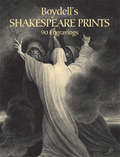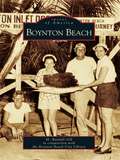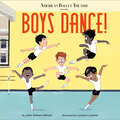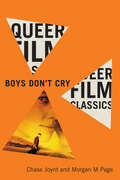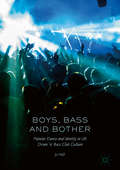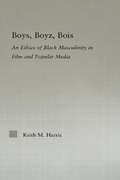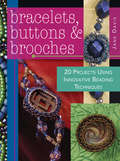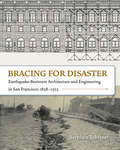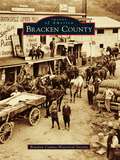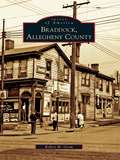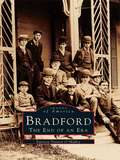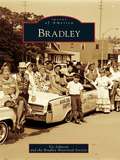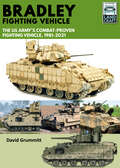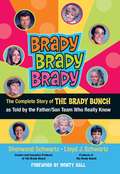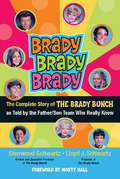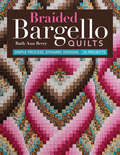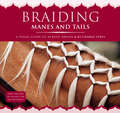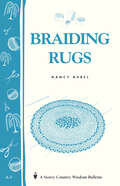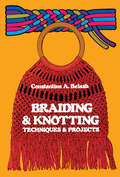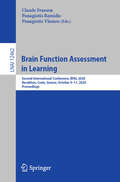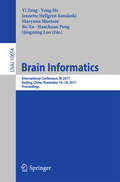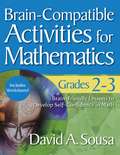- Table View
- List View
Boydell's Shakespeare Prints: 90 Engravings
by Josiah Boydell John BoydellThis impressive collection of engravings illustrating the dramatic works of Shakespeare takes a new look at the long-neglected area of romantic early-19th-century art. Nearly 100 illustrations depict dramatic scenes from AMidsummer Night's Dream, The Merry Wives of Windsor, Tempest, Two Gentlemen of Verona, Measure for Measure, Macbeth, Julius Caesar, Hamlet, Romeo and Juliet, and King Lear, and 26 other plays. A monumental effort begun in 1787, the engravings speak as passionately to the viewer today as they did more than 200 years ago.
Boyfriend Sweaters: 19 Designs for Him That You'll Want to Wear
by Bruce Weinstein Jared FloodPerfect for Him. Perfect for Her.Everyone wants the perfect cozy sweater. One they can dress up or down. It should be simple enough for him, yet stylish and flattering for her. Rediscover the boyfriend sweater, a versatile garment that both guys and girls will fall head over heels for. Knitwear designer Bruce Weinstein has reinvented the classic boyfriend sweater with 19 ultra-comfortable projects designed to work on both men and women. Knit up a luxurious cardigan perfect for any important occasion, a varsity pullover with his-and-her initials, or one of four soft and sophisticated texture-rich scarves for you or him. Throughout, you'll find tips to adapt each pattern, alter the proportions, and choose yarns to make the look more masculine or feminine. Plus, learn 19 knitting techniques you've always wanted to master, including brioche stitch, reversible cables, and Fair Isle, as well as seaming techniques to give your projects a professional finish.Whether you're knitting for yourself or for the man in your life, these gorgeous projects are sure to be classics you'll wear--or borrow--for years to come.
Boynton Beach
by Boynton Beach City Library M. Randall GillBoynton Beach, located on South Florida's Atlantic coast, is known as the "Gateway to the Gulf Stream." Ernest Hemingway once called these great ocean currents the last wild country left. Fishermen who study navigational charts understand that Boynton Beach is unique as the closest community to the Gulf Stream. Just minutes from the Boynton Inlet, water reaches a depth of 800 feet. Maj. Nathan Boynton came to the area in 1894, built a hotel, and envisioned a prosperous future for the idyllic village. Today Boynton Beach celebrates its diverse population, ideal location, and a rich and fascinating history that includes Henry Flagler's railroad, land booms, hurricanes, shipwrecks, and steadfast farmers.
Boys Dance! (American Ballet Theatre)
by John Robert AllmanA lively and encouraging picture book celebrating boys who love to dance, from the renowned American Ballet Theatre.Boys who love to dance are center stage in this encouraging, positive, rhyming picture book about guys who love to pirouette, jeté, and plié. Created in partnership with the American Ballet Theatre and with the input of their company's male dancers, here is a book that shows ballet is for everyone.Written by the acclaimed author of A Is for Audra: Broadway's Leading Ladies from A to Z, this book subtly seeks to address the prejudice toward boys and ballet by showing the skill, hard work, strength, and smarts is takes to be a dancer. Fun and buoyant illustrations show boys of a variety of ages and ethnicities, making this the ideal book for any boy who loves dance. An afterword with photos and interviews with some of ABT's male dancers completes this empowering and joyful picture book.
Boys Don't Cry (Queer Film Classics)
by Chase Joynt Morgan M PageHailed as groundbreaking upon its original release, the Oscar-winning film Boys Don’t Cry offered the first mainstream access to transmasculine embodiment in North America, one that many simultaneously celebrated and rejected. More than two decades after its original release, the film has become a lightning rod for contemporary debates about the representation of trans lives and deaths on screen.Representational possibilities for trans people have changed dramatically since 1999. Morgan Page and Chase Joynt approach the accumulated tension with a spirit of curiosity about the limits of these historical returns. They argue that new visibilities of transness on screen require us to re-engage earlier portrayals: Boys Don’t Cry is central to conversations about casting, violence against gender non-conforming people, and the borders between butch and trans identities. Acknowledging a younger generation of queer and trans people who are straining against the images foisted upon them, including this film’s egregious violence, and an older cohort for whom it remains a formative, if complicated, touchstone, Joynt and Page revisit the original contexts of production and distribution to unsettle the overdetermined ways the work has been understood and interpreted.Boys Don’t Cry ultimately relocates the film in a way that attends to the story’s violence and values, both on and off screen.
Boys, Bass and Bother: Popular Dance and Identity in UK Drum ’n’ Bass Club Culture
by Jo HallThis book uses ethnographic research to examine the role of dance in the construction of identity in the distinctly British electronic dance music club culture of drum ’n’ bass. Dancing is revealed as the central way in which drum ’n’ bass clubbers construct and perform their identities, which are informed, although not defined, by the club culture’s histories. The intertextual and intercultural development of drum ’n’ bass musical and clubbing culture is shown to be represented in the dancing body, prompting a challenge to the discourse of cultural appropriation. Popular representations of identities are embodied by drum ’n’ bass clubbers through affective transmission via the popular screen, and in this process are re-valued in their embodiment. Using a socially orientated understanding of intertextuality, the popular dancing body is shown to be heterocorporeal: containing traces of prior meaning and logic yet replete with new meaning and significance.
Boys, Boyz, Bois: An Ethics of Black Masculinity in Film and Popular Media (Studies in African American History and Culture)
by Keith HarrisBoys, Boyz, Bois concerns questions of ethics, gender and race in popular American images, national discourse and cultural production by and about black men. The book proposes an ethics of masculinity, as ethnics refers to a system of morality and valuation and as ethics refers to a care of the self and ethical subject formation. The texts of analysis include recent films by black/African American filmmakers, gangsta rap and hip-hop and black star persona: texts ranging from Blaxploitation and New Black Cinema to contemporary music video to autobiography and the public image of Sidney Poitier. The book is a significant contribution to cultural studies and gender studies and critical race theory. What is distinctive about the book is the question of ethics as a question of race and gender.
Bracelets, Buttons & Brooches: 20 Projects Using Innovative Beading Techniques
by Jane DavisBrooches, Buttons & Bracelets teaches you how to use a few basic beadwork techniques to create a beautiful beaded brooch, a button to adorn a favorite jacket, or a stunning bracelet with an attitude all its own. Whether you prefer using existing buttons, or designing you own, this beautiful bead book will help you expand your basic skills, through 200+ step-by-step photos and illustrations of techniques including peyote stitch, brick stitch, ladder stitch and fringe, features in 24 projects. In addition, you'll discover instructions for two types of cabochon beadwork and bead encasing.
Bracing for Disaster: Earthquake-Resistant Architecture and Engineering in San Francisco, 1838–1933
by Stephen Tobriner&“The first history of seismic engineering in San Francisco . . . spiced with survivor and eyewitness accounts. &”—Midwest Book Review For the past one hundred and fifty years, architects and engineers have quietly been learning from each quake and designing newer earthquake-resistant building techniques and applying them in an ongoing effort to save San Francisco. Bracing for Disaster is a fresh appraisal of a city responding to repeated devastation. In the language of a skilled teacher, Tobriner examines what really happened during the city&’s earthquakes—which buildings were damaged, which survived, and who were the unsung heroes. Filled with more than two hundred photographs, diagrams, and illustrations, this is a revealing look at the history of buildings by a true expert, and it offers lessons not just for San Francisco but for any city beset by natural disasters. &“The real saga is how a fast-growing city grapples with the reality that it has more to worry about than fires and fog. The core of the story is fairly technical, rooted in the crude intuitive ways in which builders reacted to a seismic threat they could neither measure nor define. But Tobriner crafts the story well.&”—SFGate
Bracken County
by Bracken County Historical SocietyBracken County is home to Augusta, named one of the top 10 historic sites in the state by Kentucky's foremost historian, Dr. Thomas D. Clark. Early historians referred to Augusta as a "beautiful situation" where the Ohio River flows below its banks for 9 miles without bends. From the Ohio River, early settlers such as William Bracken and Philip Buckner risked death to travel the hollow hills in search of salt wells and fertile soil. However, they returned to the area adjacent to the river where Buckner brought settlers to inhabit the former Fort Ancient Native American burial grounds. Those who followed brought with them a desire for a cultivated life. The early trustees founded private schools, Bracken Academy, and the first Methodist college in the world so that their sons and daughters could receive a superior education.
Braddock, Allegheny County
by Robert M. GromBraddock, Allegheny County is named after British general Edward Braddock, a military leader whose miscalculation of Native American fighting prowess cost him fame, glory, and life in 1755. The place of defeat was long remembered as Braddock's Field. The battle was a world-changing event, as it altered the course of American and world history. George Washington was the most memorable participant. His experiences proved invaluable during America's war for independence. Braddock's Field later served as a gathering point for whiskey tax protestors wishing to express their outrage upon horror-struck residents of Pittsburgh. Miners, factory workers, and shopkeepers soon displaced farmers. Andrew Carnegie built his first steel mill, a facility of such magnitude that it became the impetus for creating U.S. Steel Corporation. Carnegie also built his first American public library here. Drawing from the archives of Braddock Carnegie Library and area residents, Braddock, Allegheny County chronicles the evolution of this resilient community.
Bradford College
by Dr Patricia O'MalleyA special place of learning began in Bradford, Massachusetts, on the banks of the Merrimack River in 1803. It was christened Bradford Academy and it grew and flourished for almost two hundred years. A new identity and a new name came in 1932 when the academy became Bradford Junior College. For almost forty years, BJC held a distinguished position as one of the best of the nation's junior colleges. A second, almost revolutionary, transformation occurred in 1971. Bradford became coeducational and earned the right to grant the baccalaureate degree with a four-year course of study. Since 1971, the college has maintained a reputation for innovative teaching with a rigorous liberal arts curriculum within a small, caring community of scholars and learners. In the millennial year 2000, Bradford completed 197 years of service to academia. With change on the horizon, it is timely to view this special place, with its special people, called Bradford.
Bradford: The End of an Era
by Patricia Trainor O'MalleyFor more than 225 years, the town of Bradford, Massachusetts, led an independent life on the Merrimack River. Stately homes lined its main roads, a classic New England common graced its center, and high on a hill stood Bradford Academy, the town's best-known institution. In November 1896, Bradford's long independence came to an end when the town's voters agreed to annexation by the city of Haverhill. Through the camera's eye, readers can stroll through the old town from the bridge to the Common, east along Salem Street and west to the railroad depot. They can visit Ward Hill, the once-sleepy farming community whose transformation to a planned factory village triggered the annexation.
Bradley (Images of America)
by Vic Johnson Bradley Historical SocietyAt the age of 49, Ohio-born J. Herman Hardebeck had earned a gilt-edged reputation as a real estate developer in Kankakee. In the spring of 1891, to the north of Kankakee and south of Bourbonnais, lay a flat, mile-wide prairie. The land stretched eastward from a grove of Kankakee river timber, past the Illinois Central Railroad into the watershed of Soldier Creek. In May, Hardebeck signed agreements with Alvah Perry and Hiram Goodwin for the purchase of 340 acres of this property. He had taken options on additional tracts. Here Hardebeck would establish an industrial community first named North Kankakee and later renamed Bradley in honor of farm implement manufacturer David Bradley.
Bradley Fighting Vehicle: The US Army’s Combat-Proven Fighting Platform, 1981–2021 (LandCraft #9)
by David Grummitt8 pages of full color illustrations depicting 14 different vehicles.The Bradley Fighting Vehicle was developed in the 1970s to counter the new Infantry Fighting Vehicles of the Soviet Union and its Warsaw Pact allies. Designed to survive the imagined high-intensity, Nuclear, Biological and Chemical (NBC) battlefield of the Cold War, it became, alongside the M1 Abrams Main Battle Tank, the mainstay of US armoured forces during the 1980s. As the Cold War ended, however, it would go on to prove its worth on other battlefields. During the First Gulf War the Bradley would destroy more Iraqi AFVs than the Abrams, while during the 1990s it would prove itself an effective weapons system in the missions to Bosnia and Kosovo. During the 2003 invasion of the Iraq and the fighting that followed it confirmed its reputation as a versatile and deadly AFV. This volumes examines the development and service history of both the M2 Bradley Infantry Fighting Vehicle and the M3 Bradley Cavalry Fighting Vehicle. The various modifications and improvements over its long service history are described, as is the experience of the soldiers who have fought alongside and in it during the past three decades. The book also gives a full account of the wide range of kits and accessories available in all the popular scales and includes a modelling gallery covering the most important Bradley variants. Detailed color profiles provide both reference and inspiration for modellers and military enthusiasts alike.
Brady Brady Brady: The Complete Story of the Brady Bunch as Told by the Father - Son Team Who Really Know
by Sherwood Schwartz Lloyd J. SchwartzThe Brady Bunch is one of the most beloved series to ever grace American television screens. Whether you've been a devoted fan since its inception in the late 1960s, or are a more recent Brady buff thanks to its steady airing in syndication, there is an undeniable shared delight that comes from the simple-natured, humor-filled world of that picture-perfect family. Now, for the first time, the show's famous creator, writer, and producer Sherwood Schwartz and his son, writer and producer Lloyd Schwartz, share with their loyal audience the complete first-hand behind-the-scenes story of The Brady Bunch. From how the show was developed, pitched, greenlighted, cast, produced, and embraced, to ultimately how it changed the TV and cultural landscape of America; this book really has it all. Sherwood and Lloyd Schwartz carefully and nostalgically recall all the details; great, small, funny, frustrating, and everything in between; that came with the show. Taking an exclusive tour of everything Brady, you'll marvel at the stories, take pleasure in more than 50 rare photographs, and transport yourself into the show you love with the insider details you never knew.
Brady, Brady, Brady: The Complete Story of The Brady Bunch as Told by the Father/Son Team who Really Know
by Sherwood Schwartz Lloyd J. Schwartz"The Brady Bunch" is one of the most beloved series to ever grace American television screens. Whether youOCOve been a devoted fan since its inception in the late 1960s, or are a more recent Brady buff thanks to its steady airing in syndication, there is an undeniable shared delight that comes from the simple-natured, humor-filled world of that picture-perfect family. Now, for the first time, the showOCOs famous creator, writer, and producer Sherwood Schwartz and his son, writer and producer Lloyd Schwartz, share with their loyal audience the complete first-hand behind-the-scenes story of "The Brady Bunch. " From how the show was developed, pitched, greenlighted, cast, produced, and embraced, to ultimately how it changed the TV and cultural landscape of America?this book really has it all. Sherwood and Lloyd Schwartz carefully and nostalgically recall all the details?great, small, funny, frustrating, and everything in between?that came with the show. Taking an exclusive tour of everything Brady, youOCOll marvel at the stories, take pleasure in more than 50 rare photographs, and transport yourself into the show you love with the insider details you never knew. "
Braided Bargello Quilts: Simple Process, Dynamic Designs—16 Projects
by Ruth Ann BerryDiscover the simple techniques behind advanced Bargello quilts in this guide by the author of Bargello: Quilts in Motion—featuring 16 all-new projects! Quilter Ruth Ann Berry is a master of Bargello techniques. Here she shares the simple construction secrets behind captivating designs that feature flowing braids of color. This follow-up to her successful guide Bargello: Quilts in Motion features 16 new projects, from bed quilts to wallhangings. Weaving in more design elements and colorways, you'll be able to work 20 or even 40 fabrics into a single quilt! Track your progress with a design chart and learn expert tips for fabric cutting and strip piecing.
Braiding Manes and Tails: A Visual Guide to 30 Basic Braids
by Charni LewisGive your horse a gorgeous look! Charni Lewis provides step-by-step instructions for 30 mane and tail braids for both casual outings and specialized events of all riding styles. Full-color photographs and detailed illustrations bring every twist and turn to life, while also clearly demonstrating proper hand positioning. Get inspired and experiment with a Scalloped mane braid or a Four-Strand Weave for the tail. Not only will your horse look great, the time you spend braiding will help develop that special bond between you and your horse.
Braiding Rugs: A Storey Country Wisdom Bulletin A-03 (Storey Country Wisdom Bulletin Ser.)
by Nancy BubelBraided rugs are like family quilts – each strip of cloth comes from a cast-off garment and tells a story all its own. Piecing the rug together is an act of weaving family memories into a useful heirloom you'll treasure forever. Nancy Bubel covers every step of the simple process, from planning the perfect size, shape, and color scheme to cutting your cloth strips, braiding them together, and finishing off your rug.
Braiding and Knotting: Techniques and Projects
by Constantine A. BelashAll you need is three or more pieces of string, rope, cord, or some other pliable material and you're ready to begin! This book will teach you how to braid, weave, and knot them in hundreds of different ways, from simple three-stranded braiding through the attractive -- though more complex -- macramé knotting.Complete, easy-to-follow instructions begin with braiding and weaving with anywhere from three to nine strands. Flat braiding, solid braiding, braiding over multiple strands, weaving across stationary strands, and many other techniques are covered. Each yields a different texture and pattern, so that with the imaginative use of color the results can be quite attractive. The knotting section covers the many different kinds of knots (square, spiral square, triple, half hitch, etc.) and how to use them in various decorative or functional ways. Fifty-seven drawings are especially helpful in adding clarity to the directions.Along with these instructions there are directions for making numerous articles with your braids and knots: belts, lanyards, mats, rugs, sandals, hats, bags -- only your imagination will limit the number of things you can make. Anyone inclined to take up braiding and knotting will find this book immensely helpful, not only in getting started, but in going through the advanced stages of crafts.
Braillables: A Manual for Parents and Teachers - Techniques for Teaching Drawing with Braille
by Marie PorterFrom the book: Braillables are pictures that are brailled by people who are able to braille them. They are outlines, sketches, sculptures, drawings, artwork. They are a creative expression that uses a necessary skill of blind people. They are fun to do, easily shared by sighted people, and they give an added dimension of freedom in using what can be a very rigid mode of communication. Blind people can draw in a medium over which they have complete control. Drawing with braille builds skill in reading, in interpreting charts, maps, diagrams, math and science figures. For those who pursue it, drawing with braille encourages imagination, creativity, a feeling for abstraction, perspective and proportion--all elements necessary for good concepts of objects, spatial relationships, and, ultimately, skill in orientation and mobility. Braille has an aura of mystery about it which isolates the reader. It can be austere, unpenetrable, a symbol of struggle and pain both for the blind person and for the family and friends. There is a coming together, a sharing, a breaking down of barriers when two heads bend over a picture of a dog and both the blind person and the sighted person see it as a dog. That is the fun of it.
Brain Function Assessment in Learning: Second International Conference, BFAL 2020, Heraklion, Crete, Greece, October 9–11, 2020, Proceedings (Lecture Notes in Computer Science #12462)
by Claude Frasson Panagiotis Bamidis Panagiotis VlamosThis book constitutes the thoroughly refereed proceedings of the Second International Conference on Brain Function Assessment in Learning, BFAL 2020, held in Heraklion, Crete, Greece, in October 2020*.The 11 revised full papers and 10 short papers presented were carefully selected from 35 submissions. The BFAL conference aims to regroup research in multidisciplinary domains such as neuroscience, computer science, medicine, education, human-computer interactions, and social interaction on the theme of Brain Function Assessment in Learning.*The conference was held virtually due to the COVID-19 pandemic.
Brain Informatics: International Conference, BI 2017, Beijing, China, November 16-18, 2017, Proceedings (Lecture Notes in Computer Science #10654)
by Yi Zeng, Yong He, Jeanette Hellgren Kotaleski, Maryann Martone, Bo Xu, Hanchuan Peng and Qingming LuoThis book constitutes the refereed proceedings of the International Conference on Brain Informatics, BI 2017, held in Beijing, China, in November 2017. The 31 revised full papers were carefully reviewed and selected from 64 submissions. BI addresses the computational, cognitive, physiological, biological, physical,ecological and social perspectives of brain informatics, as well as topics related tomental health and well-being.
Brain-Compatible Activities for Mathematics, Grades 2-3
by David A. SousaDemonstrating instructional principles discussed in David A. Sousa’s How the Brain Learns Mathematics, this resource provides brain-friendly, ready-to-use mathematics lessons for Grades 2-3. Teachers will find step-by-step guidance and all the necessary reproducible materials for mathematics instruction that involves group work, reflection, movement, and visualization. Through activities such as Jumping Jelly Beans, Math Hockey, and Treasure Hunt, young learners will enjoy developing skills connected with number patterns and place value, multi-digit addition and subtraction, multiplication and division, fractions, measurement, geometry, and more.Aligned with NCTM standards and focal points, the instructional strategies:Enhance motivation and content retentionAddress individual intelligencesPromote writing as an important learning toolUse concrete models to make concepts meaningfulConnect mathematical ideas to the real worldTeach creative problem solvingDeepen and revitalize instruction using Sousa’s proven brain-compatible approach for helping every student develop self-confidence in mathematics!
